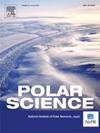在能源转型的气候制度下区分土著人民与当地社区:对因纽特人和萨米人的影响
IF 1.5
4区 地球科学
Q3 ECOLOGY
引用次数: 0
摘要
气候制度下土著人民和当地社区之间的区别最初是在《联合国气候变化框架公约》下解决的,最近由于能源政策的变化而重新引起人们的关注,以应对迅速的气候变化,例如在阿拉斯加。蒙大拿州的气候诉讼表明,由于在现代社会中很难明确区分与气候相关的独特土著文化,并且很难获得当地社区的同情,反对仅仅寻求土著权利的诉讼,但土著人民自己可能并不认为需要和谐,因此,通过明确识别独特的与气候相关的土著文化,避免无意的冲突,可以实现土著人民和当地社区的和谐。土著和社区保护区(ICCAs)是通过指定土著人民的原始土地来实现《生物多样性公约》下30乘30目标的一种方法,但可能不利于维护固有权利,如果他们与当地社区合作,也可能是实现和谐的最佳方式。如果发生与挪威福森案类似的案件,芬兰当地的非萨米驯鹿牧民将不像挪威的萨米牧民那样受到《公民权利和政治权利国际公约》的保护。由于能源转型本身并不能自动反映土著人民的观点,当他们的权利不被考虑时,绿色殖民主义很容易发生。本文章由计算机程序翻译,如有差异,请以英文原文为准。
Differentiating Indigenous Peoples from local communities under climate regimes in just energy transition: Implications for the Inuit and Sami Peoples
The distinction between Indigenous peoples and local communities under climate regimes was initially addressed under the UNFCCC and has recently garnered renewed attention owing to energy policy changes to cope with rapid climate change such as in Alaska. The Montana climate litigation demonstrates the possibility of harmonizing Indigenous peoples and local communities by clearly identifying the unique climate-related indigenous culture and avoiding unintentional confrontation, given the difficulty of making clear distinctions in modern society and garnering sympathy from the local community against litigations that solely seek indigenous rights, but Indigenous peoples themselves may not see the need for harmony. Indigenous and Community Conserved Areas (ICCAs) is one approach to achieve a 30 by 30 target under the CBD by designating Indigenous peoples' original land but may not be beneficial to assert inherent rights or the best way to achieve harmony if they work with local communities. The local community of Finnish non-Sami reindeer herders will not receive protection under the ICCPR unlike Sami herders in Norway, if a case similar to Norway's Fosen case occurs. As just energy transition alone does not automatically reflect the perspectives of Indigenous peoples, green colonialism could easily occur when their rights are not considered.
求助全文
通过发布文献求助,成功后即可免费获取论文全文。
去求助
来源期刊

Polar Science
ECOLOGY-GEOSCIENCES, MULTIDISCIPLINARY
CiteScore
3.90
自引率
5.60%
发文量
46
期刊介绍:
Polar Science is an international, peer-reviewed quarterly journal. It is dedicated to publishing original research articles for sciences relating to the polar regions of the Earth and other planets. Polar Science aims to cover 15 disciplines which are listed below; they cover most aspects of physical sciences, geosciences and life sciences, together with engineering and social sciences. Articles should attract the interest of broad polar science communities, and not be limited to the interests of those who work under specific research subjects. Polar Science also has an Open Archive whereby published articles are made freely available from ScienceDirect after an embargo period of 24 months from the date of publication.
- Space and upper atmosphere physics
- Atmospheric science/climatology
- Glaciology
- Oceanography/sea ice studies
- Geology/petrology
- Solid earth geophysics/seismology
- Marine Earth science
- Geomorphology/Cenozoic-Quaternary geology
- Meteoritics
- Terrestrial biology
- Marine biology
- Animal ecology
- Environment
- Polar Engineering
- Humanities and social sciences.
 求助内容:
求助内容: 应助结果提醒方式:
应助结果提醒方式:


